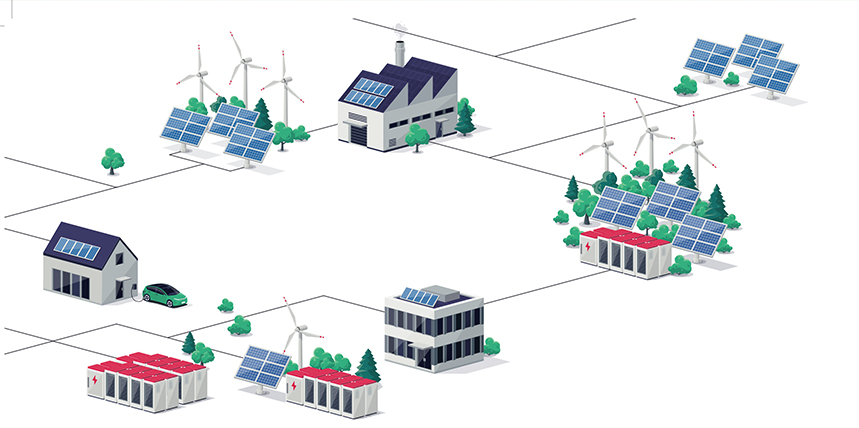Microgrids are gaining ground in different parts of the world with each passing year. In the United States, one of the main drivers advancing the concept of microgrid was Hurricane Sandy. This hurricane, which hit the northeast part of the US in 2012, caused havoc with the transmission and distribution system. The advantages presented by smaller, self-sustaining grids began to look very attractive, and there was a much greater interest in such small grids.
However, a microgrid is not a new concept. If we look in the rearview mirror, we find that the original concept of a microgrid dates back to the 1800s. In 1882, Thomas Edison had built the first commercial direct current (DC) power plant. This plant, which was named the Manhattan Pearl Street Station, was part of a small grid serving 82 customers with a distribution area of a few blocks. The plant also served as a combined heat and power source to those customers. In addition, batteries at this plant served as power storage. This distribution was a standalone system with no external grid present.
As years went by, alternating current (AC) began to win the race with DC (direct current), and the electrical grid as we know it today started taking shape. The energy sector started expanding and finally evolved into large electric utilities that generated, transmitted, and distributed electric power. The result of this was a massive mesh of interconnected grids spanning the entire US. A similar evolution took place in Europe followed by Asia and other parts of the world.
PURPA ENACTED
The next big step in the electrical energy sector in the United States occurred in 1978. In that year, the Public Utility Regulatory Policies Act was enacted (PURPA). This act had its origins in the energy crisis of 1970s. The intent of PURPA was to encourage cogeneration and renewable sources that would promote competition and conservation. This resulted in several industrial plants installing steam/gas turbine generation. The local generators provided both electric power and steam for the plant’s use. The generators operated in parallel with the grid. The plant could sell excess power to the host utility. In case of loss of the utility grid, the generators supplied the local plant load. Some plants supplied the local load, and only if the local generator was lost would the host utility start to provide power to the plant in a seamless fashion. During undervoltage conditions in the grid, the local generator provided reactive power to stabilize the grid voltage.
Later on, several independent power producers started building power plants to sell power to the electric utilities. PURPA had a clause that required the host utility to purchase power from these entities at reasonable prices. In several instances, host utilities offered attractive rates if the plant owners agreed to support grid stabilization by supplying real power (MW) and reactive power (MVAR).
OLD COGENERATION CONCEPTS VS. NEW MICROGRIDS
Local generation at the plant along with the plant distribution was, in fact, a microgrid. The generator supplied the local load, and the plant had the option of switching the load over to the grid. This sounds very familiar with what we see today with microgrids.
The in-house generation was also installed at parks, prison facilities, large telecommunication centers, etc., and the same applies to microgrids of today.
Microgrids consist of a diverse mix of distributed generation such as wind turbines, solar panels, fuel cells, and biomass fuels. If supported by battery storge, all of these will enable power to be available around the clock. Microgrids have two advantages: the declining cost of lithium-ion batteries and the increasing affordability of renewable energy.
There are some differences between the microgrids we see today and the old cogeneration facilities:
- The generation at industrial plants, commercial facilities, parks, and jails consists of one or several generators at one location. This is not the case with microgrids; generation is dispersed.
- Conventional generators did not create harmonics; microgrids do generate harmonics. The issue of harmonics is resolved by applying appropriate filtering.
- The short-circuit current provided by the generators at cogeneration facilities is adequate to accommodate effective relaying at both medium- and low-voltage buses. Renewable sources do not provide adequate short-circuit currents.
- Microgrids do not possess adequate inertia to support system stability.
- Most of the generation in a microgrid comes from renewable sources, but a microgrid can also contain a conventional source.
- Microgrids with renewable sources are environmentally friendly and provide clean energy.
- In the case of microgrids, the load is not necessarily one concentrated plant or facility. The load may consist of a mix of loads such as homes, schools and a hospital spread over a specific area.
Hence, we can see that the microgrids of today have several similarities to older cogeneration facilities with some exceptions. The advances made in the areas of automation, communication, and digitalization make the microgrid quite different.
MICROGRID ISSUES AND SOLUTIONS
There is no doubt that microgrids provide an array of benefits. However, microgrids do present some issues and challenges that the industry is addressing to find solutions.
- In situations where the microgrid operates in an isolated mode with no synchronous generator, starting large motors will be difficult.
- Coordination between protective devices based on simple overcurrent relays is difficult. This is due to inadequate magnitude and time duration in the short-circuit current that is present. This will be true for coordination between 480/277 V, as well.
- Differential relaying for transformers and lines at several locations will be required to provide a coordinated system with the required level of selectivity.
- Protective schemes will require adaptive relaying coupled with communication links between various protective devices.
- Application of protective devices that are compliant with IEC 61850 will be helpful. This means implementing protection based on GOOSE messaging, which provides a good option.
- The 480 V devices consist of molded-case circuit breakers and breakers with solid- state trip units. There is no formal coverage of 480 V devices in IEC 61850. However, manufacturers have devised means of incorporating these devices into IEC 61850-based schemes.
- One of the drivers that pushed microgrids was the fact that when the main grid is lost during storms, the microgrids can keep supplying power to the assigned loads. However, this may not be true if the microgrid coverage area includes overhead distribution lines. Underground distribution will help alleviate this issue.
- A lot of research is going on in the area of enhancing the converters applied at renewable generation. The issue of inertia and the lack of adequate short-circuit current from the magnitude and time duration perspectives is being addressed.
 Ed Khan has been with Doble Engineering Company for 14 years working in various capacities including Product Manager for protection testing-related instruments. He is currently the Director of Protection R&D and Protection Training at Doble. In this capacity, he manages and conducts the relay protection training program. Prior to Doble, Ed worked for GE, ABB, SEL, KEMA, and others in various capacities. He has 38 years of experience in system studies, protection applications, relay design, power plant design, teaching, and product management. He has thorough knowledge about product development, protection, harmonic analysis, harmonic filter design, stability studies, real-time digital simulations, generator protection, and more. Ed has written several articles and has made presentations at several venues. He holds an MS in electrical engineering from Texas A&M University.
Ed Khan has been with Doble Engineering Company for 14 years working in various capacities including Product Manager for protection testing-related instruments. He is currently the Director of Protection R&D and Protection Training at Doble. In this capacity, he manages and conducts the relay protection training program. Prior to Doble, Ed worked for GE, ABB, SEL, KEMA, and others in various capacities. He has 38 years of experience in system studies, protection applications, relay design, power plant design, teaching, and product management. He has thorough knowledge about product development, protection, harmonic analysis, harmonic filter design, stability studies, real-time digital simulations, generator protection, and more. Ed has written several articles and has made presentations at several venues. He holds an MS in electrical engineering from Texas A&M University.
